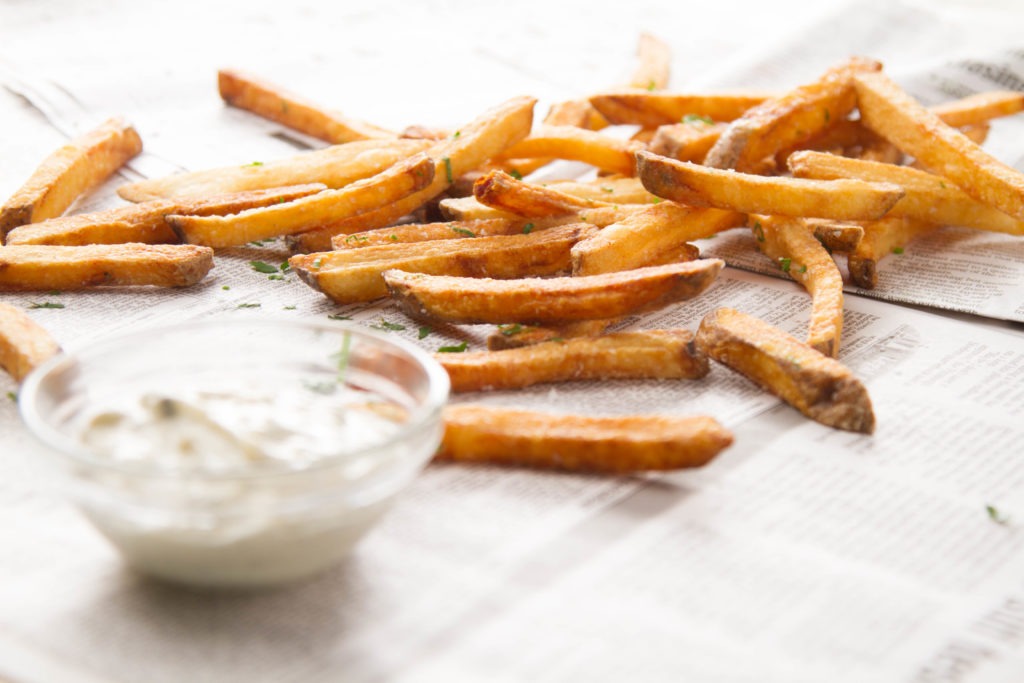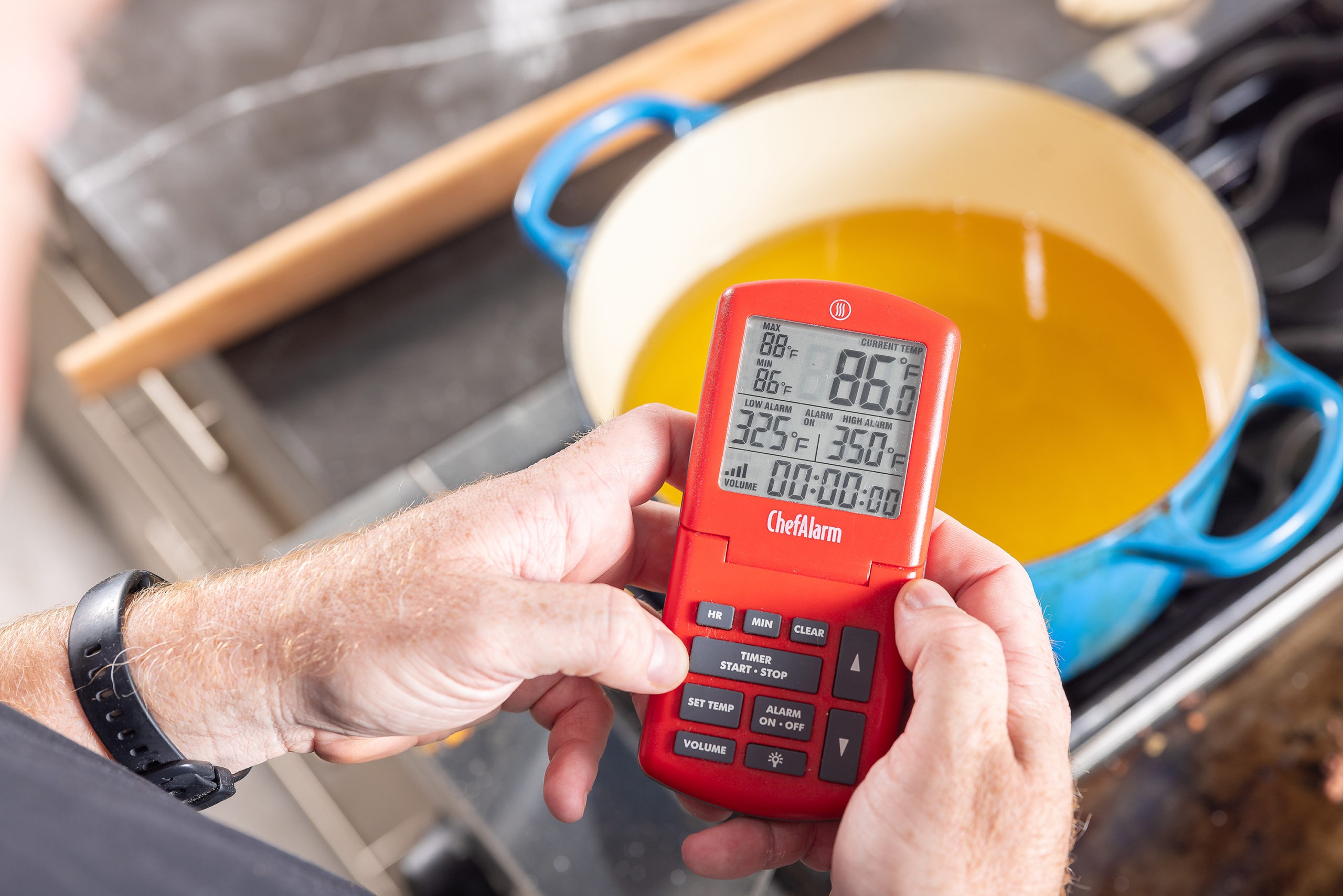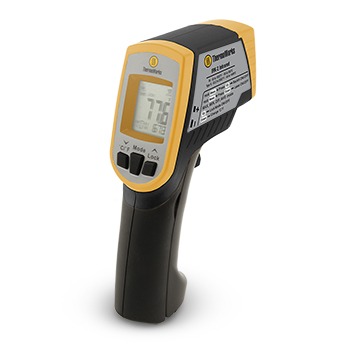Oil Smoke Points: Thermal Principles and Temp Chart
When we talk about deep frying or even sauteeing, food writers often say something like “use a neutral-flavored, high smoke-point oil.” We might then recommend one of our favorites, such as corn or peanut. But why? Why are we writing this same odd instruction over and over again? And what does it mean? And should you care? In this post, we will explain what smoke point is, what it means to you as a cook, and provide you with a chart of smoke point temperatures that you can use to make your own decisions about which oil to use. So get your ChefAlarm® or Thermapen® ONE ready, it’s going to get hot!
Oil smoke point explained
What are oils and fats?
To understand smoke points, we first need to understand what oils and fats are. First, oils are the same thing as fats, but fats are generally solid at room temperature, while oils are liquid. Here, we’ll just refer to the group as “oils.” Oil molecules are made of groups of three fatty acids of varying lengths, all connected to a glycerol molecule. (Hence the name triglycerides.)
Each of those fatty acid chains can be either saturated or unsaturated. Saturated fats have a hydrogen atom at every location where one can be. Unsaturated fats have hydrogens missing, where carbon atoms have to form double bonds. That double bonding causes the chain to bend. If more than one hydrogen is missing (poly-unsaturated), it’s even bendier.
Why does any of this matter? Stacking. If all the fatty acids in an oil are saturated, they form straight, block-like molecules that can stack on top of each other easily. That ready stackability is why saturated fats are more likely to be solid at room temp. But if many of the fatty acids are bent, they don’t lay flat and compress; they stay liquid. Think of a ream of paper stacked neatly vs. a ream of paper that has been through a shredder—the same amount of paper takes up more space.
But oils also contain fatty acids that are not bound up with a glyceride. These are known as “free fatty acids,” and their presence in an oil helps determine its smoke point.
What is the smoke point?
Fats start to break apart at temperatures well below their boiling points. You’ll almost never see oil boiling on its own, because its vapors would ignite before that was likely to happen. (When we fry things in oil, it is the water of the food that is boiling, not the oil itself.) What you will see, however, is wisps of smoke starting to appear on the surface of the oil.
The characteristic temperature at which a fat breaks down into visible gaseous products is called the smoke point.
—Harold McGee, On food and Cooking, pg. 802
Oils with a lower free-fatty acid content tend to be more stable and have a higher smoke point. Those happen to be, for the most part, plant-derived oils. Most plant oils, if they are not yet rancid, begin to smoke at about 450°F (230°C). Most animal oils (butter fat, beef tallow, chicken schmaltz), with their higher free-fatty acid content, begin to smoke in the neighborhood of 375°F (190°C).
Does it matter? Oh yes!
Not only are the smoky fumes obnoxious, but the other materials that remain in the liquid, including chemically active free fatty acids, tend to ruin the flavor of the food being cooked.
—Harold McGee, On food and Cooking, pg. 802
If you’ve ever been around a deep fryer that has not had an oil change for a while, you know how that can smell. The characteristically “oily” aroma of a dirty fryer is a result of the decomposition of the oil. When you cook, you want to taste the food, not the oil it was cooked in. And you want your cooking to be safe. Push an oil beyond its smoke point too far, and it will ignite!

Other factors: non-refined oils
Many of our cooking oils are very highly refined. (So much so that refined peanut oil doesn’t even count as a peanut allergen!) But some are less refined. Extra-virgin olive oil, for instance, has a lot in it that isn’t pure oil. All those tasty flavor molecules burn at temperatures below the smoke point of the oil itself and cause bad flavors before the “oil” starts to smoke. So EVOO has a lower smoke point than “light” olive oil, which has had many of those tasty compounds removed. Light olive oil is better for many cooking tasks than EVOO because of this. The same goes for butter. Butter solids burn well before the butter fat wants to; that’s why clarified butter is a better cooking fat than whole butter.
Making sure your oil doesn’t taste bad
Note that the decomposition happens faster the closer to the smoke point that you get. Oil will still go “bad” over time because of use, but it will get there very quickly if you get it to (or close to) the smoke point. So, while we won’t be deep frying anywhere near 450°F (230°C), we want an oil with a smoke point that is well above our cooking temperature.
Using the right oil for your cooking tasks matters. If you use a low-temp oil for a high-heat sauté, you’ll end up with off-tasting flavors, even though the oil was only cooked for e few minutes. If you have a pot of fry oil on the stove, it will stay “fresh” tasting for longer if you manage to keep it further from its smoke point. For both tasks, but more especially the deep frying, you can use your ChefAlarm or Thermapen to monitor the oil and keep it within the correct cooking range. You can even use an infrared thermometer in a sauté pan to check the oil temp.
Use the charts below to help you choose the oil for your next project, then keep an eye on its temperature while you cook to maintain its quality for longer.
High-heat oil smoke points
| Oil Type | Smoke Point |
|---|---|
| Peanut (refined) | 450°F (232°C) |
| Safflower | 450°F (232°C) |
| Soybean | 450°F (232°C) |
| Grapeseed | 421°F (216°C) |
| Canola | 435°F (224°C) |
| Corn | 410°F (210°C) |
| Sunflower | 410°F (210°C) |
| Avocado (refined) | 520°F (270°C) |
| Butter (clarified) | 482°F (250°C) |
| Cottonseed | 428–446 °F |
| Olive (light) | ~450°F (232°C) depending on refinement |
| rice bran | 450°F (232°C) |
| Beef tallow | 480°F (250°C) |
| Oil Type | Smoke Point |
|---|---|
| Olive, extra virgin | 374°F (190°C) |
| Coconut (unrefined) | 350°F (177°C) |
| Lard | 374°F (190°C) |
| Sesame (unrefined) | 350°F (177°C) |
| Oil Type | Smoke point |
|---|---|
| Peanut, unrefined | 320°F (160°C) |
| Butter | 302°F (150°C) |
| Sunflower (unrefined) | 225°F (107°C) |
Shop now for products used in this post:






So the oil with the highest smoke point would be the best one to apply to charcoal grill grates to keep food from sticking?
Yes!
Do you know what the flash points are of the same oils in this chart?
Not all of them. One source gives the flashpoint for peanut at 633°F, canola 619°F, soybean 626°F, and cottonseed at 606°F. It seems that most oils approach their flashpoint at around 600*F, so keep them lower than that!
Are there any common additives that would lower the smoke point?
No. Either the oil is as low as it will go or it neeeds to be further purified to eliminate things in it that can burn. But there’s no lowering is as is.
Smoke point is related to FFA content of oil. There is inverse relation between FFA and smoke point. It will be helpful to many readers if you can share a chart FFA vs Smoke point.
In the body of the text, you state that “Most animal oils (butter fat, beef tallow, chicken schmaltz), with their higher free-fatty acid content, begin to smoke in the neighborhood of 375°F (190°C).”
Yet, in the chart, it says beef tallow’s smoke point is 480°. Which is it for beef tallow?
Good question. Beef tallow that you render yourself will likely have impurities in it—protein, etc— that will lower the smoke point. Highly processed, purified beef tallow has a higher smoke point. For homemade tallow, I’d assume a smoke point in the 375–400°F range.